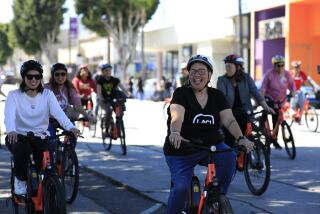Nation’s Most Successful : Private Library Fulfills Dreams of S.F. Book Lovers
- Share via
SAN FRANCISCO — The Mechanics’ Institute may not be the only private library in the United States, but it can boast about being the most successful.
It is a book lover’s dream--with nearly 200,000 fiction and nonfiction volumes, open stacks and a thorough reference service. It also is open seven days a week and late into the evening most weekdays.
Chief Librarian Kathleen Pabst said of the low, $30-a-year membership dues: “We consider this to be a gift to the Bay Area.”
Cost Is Triple Dues
Pabst said it actually costs $93 to $97 a year per member to keep the library in operation. The rest of the money, she said, comes from building rents and a permanent endowment.
Membership is open to anyone.
Pabst said there are several other private libraries in the United States.
There is a similar one in New York City, she said, but it is “not as big and not as good as the Mechanics’ Institute.” She pointed out that it only has about 2,000 members with higher dues. The reason it is not as successful, she explained, is that New York City has a good public operation and fulfills the residents’ needs.
She also said that, while San Francisco’s population has been decreasing over the years, the institute membership has been growing. “We now have 75,000 members,” she said.
Founded at End of Gold Rush
The Mechanics’ Institute had its birth at the end of the Gold Rush era in the 1850s.
Gold from the Sierra placers was running out; shipping and trade were declining. Citizens began looking toward manufacturing and agriculture to sustain the economy.
There were machine shops, foundries, shipyards, woodworking firms, tanneries, lumber and grist mills and blacksmiths in or near San Francisco.
Residents saw the need for technical education. Some Eastern cities had supplied such training by establishing mechanics’ institutes, and on April 24, 1855, the San Francisco Mechanics’ Institute was incorporated.
The first library opened in a $25-a-month room.
In 1857 the institute decided to hold a Mechanics’ and Manufacturers’ Fair to promote industry. It ran for 19 days in a pavilion it erected for $7,000. The fair netted nearly $3,000 plus the building free and clear, and the institute had its first home.
Today the library is housed in a nine-story building it owns on the fringe of the downtown financial district.
Destroyed in Earthquake
By 1906, the San Francisco institute had 4,150 members with 135,000 books. It absorbed the Mercantile Library, and on the eve of the city’s earthquake had 200,000 volumes.
The institute was destroyed by the temblor and subsequent fire. Included were priceless files of California newspapers, a complete set of British patent reports, technical, scientific, literature and artworks.
The institute had been located on what is now the Civic Center. In 1912 the city bought the property for $700,000. It became the basis for the institute’s permanent endowment.
In July, 1910, the institute bought its current home, which was designated a landmark building on Sept. 6, 1981.
Among the library’s services is the acquisition of new material. If a member desires a book not in the collection, a request can be made to the chief librarian who checks to determine whether the volume will beneficial to the library. If it is judged to be worth obtaining, the chief librarian buys it.
“We buy 300 books a month,” Pabst said. “And I check all the requests myself.”
In 1978 Californians approved Proposition 13, which reduced homeowners’ tax bills but resulted in a curtailment of many government services including city libraries through the state.
Asked whether Proposition 13 brought more than the usual number of members to the institute, Pabst said:
“No. They joined simply because it is a damn good library.”
More to Read
Sign up for Essential California
The most important California stories and recommendations in your inbox every morning.
You may occasionally receive promotional content from the Los Angeles Times.













